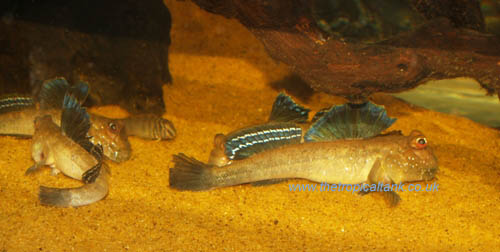
 |
||||
| Article Library | Fish Index | Tank Setups | Forum | Links |

|
|
|
|||
|
|||
|
|
|||
Tank 9: Brackish Mudskipper tank
This is a brackish tank with a built-in land area for African Mudskippers,
This tank was designed specifically for Mudskippers and I added a glass shelf to create a large land area, as these fish spend a good portion of time out of the water. The shelf is fixed in place at about 6"/15cm height to give a good water depth. A larger grained sand was added to the shelf after coating it with a thin layer of silicone sealant, this keeps the sand in place so that it isn't gradually lost over the edge of the shelf and into the water. Due to their specialised needs, it is normally advisable to keep Mudskippers in a species tank, especially the larger and more boisterous species such as P. barbarus. However, this tank was originally also home to 3 Zebra Blennies, Omobranchus zebra), a rarely imported brackish blenny. They were wily enough to live alongside the mudskippers and compete effectively for food and often seemed 'curious' about where the mudskippers were going when they climbed onto the land part to feed on crickets... The feeding in this tank consists of bloodworm, brine shrimp and krill, as well as pieces of larger foods such as mussel, prawn and whitebait. The Mudskippers are also fed crickets on the land area, to allow them to indulge in their natural behaviour of eating insects on land. Note that the crickets fed should not be too large, not fed too often in large numbers, as there could be a risk of impaction (digestion problems).
[Home] [Article Library] [Fish Index] [Tank Setups] [Forum] [Site Map] |
||||||||||||||||||||||||||||||||||||||||||||||||||||||||||||||||||
|
|
| The Tropical Tank Copyright © 2000-2022 Sean Evans | This website was last updated on 20th November 2022 |


